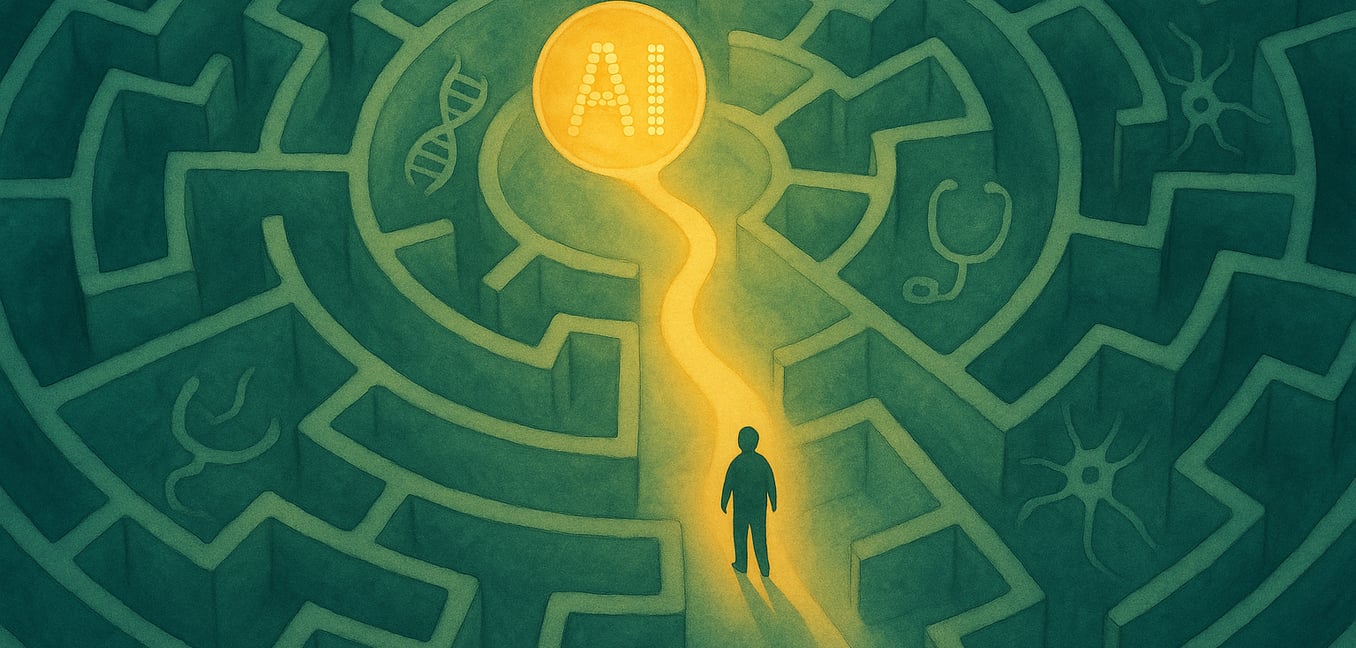What if we could teach a computer to understand the complex language of our cells? This is the core idea behind C2S-Scale. It is a new AI framework from researchers at Yale and Google. This powerful tool gives scientists a new way to explore biological data at an unprecedented scale.
For our community, new technologies often bring a mix of hope and caution. We need to look beyond the headlines to understand what they can truly do. Therefore, this article provides a detailed examination of the C2S-Scale model. We will explore how it works and what it has achieved. We will also discuss its important limitations from a realistic perspective.
What Is the C2S-Scale AI Model and How Does It Work?
To understand the importance of C2S-Scale, we must first look at the problem it solves. Modern biology relies on technologies like single-cell RNA sequencing (scRNA-seq). This technique allows scientists to see which genes are active inside a single cell. It provides a detailed snapshot of a cell's function at a specific moment.
However, this technology produces an enormous amount of data. For each cell, scientists get a list of thousands of genes with numerical expression values. This creates a high-dimensional vector of numbers. When analyzing millions of cells, this becomes a massive wall of complex data. Finding meaningful patterns in this data has required specialized computational tools. These older models often struggled to scale or integrate other forms of knowledge. This data bottleneck has been a significant challenge in accelerating biological discovery.
How Does the Cell2Sentence Create a New Language for Biology?
The core innovation behind C2S-Scale is its elegant solution to this data problem. It is called the Cell2Sentence (C2S) methodology. This framework systematically changes the complex numerical data into simple text.
How Does C2S-Scale Turn Complex Cell Data into Simple Words?
The C2S process is conceptually straightforward yet powerful. It takes the list of genes from a single cell. Then, it sorts them based on their expression levels in descending order. The model arranges them from the most active gene to the least active. The result is a rank-ordered sequence of gene names. This textual sequence is what the researchers call a "cell sentence."
Does This Process Lose Information?
A critical question is whether converting numbers to ranks loses vital information. Researchers investigated this carefully. They found that the process preserves a significant amount of biological detail. In fact, a simple linear model could reconstruct over 81% of the original gene expression variance from the rank order alone. This high preservation rate confirms the biological fidelity of the representation. It shows that the most important information is kept.
Why Text is a Game-Changer
This change from numbers to text is a fundamental strategic choice. By converting biological data into a language-like format, the model can use the power of Large Language Models (LLMs). These models are the foundation for technologies like ChatGPT. They benefit from strong scaling laws, meaning they get smarter as they grow.
This approach allowed the researchers to scale the model to an immense 27 billion parameters. Previous custom-built models for single-cell analysis could not achieve this scale. Furthermore, this textual format allows the model to natively integrate data with biomedical text. This unique ability to unify two different types of information is a key source of its power.
How Does C2S-Scale Perform?
A powerful idea is only useful if it delivers real-world results. C2S-Scale has been rigorously validated across a wide spectrum of tasks. Its performance confirms its status as a state-of-the-art tool in single-cell biology.
What Major Discovery Did C2S-Scale Make in Cancer Research?
The model's most compelling success came from a study in cancer immunotherapy. Researchers designed a highly specific in-silico experiment. They did not ask a vague question like "find a cancer drug." Instead, they asked the model to find a "conditional amplifier." They wanted a drug that would boost immune signaling only when a small amount of interferon was already present. This forced the model to look for a complex, context-dependent interaction, not just a simple correlation.
The Silmitasertib Case Study
From a screen of thousands, the model predicted a strong effect for the drug silmitasertib. This was a novel biological hypothesis. Subsequent wet-lab experiments in human cell models confirmed the prediction with striking accuracy. The drug combination did indeed amplify antigen presentation. This made cancer cells more visible to the immune system. This outcome provides definitive evidence that the model can generate testable, biologically grounded discoveries.
Beyond a Single Case: Broad Capabilities
The model's capabilities are not limited to one area. In traditional tasks, it also excels. For example, when classifying immune cell types, it achieved 95.43% accuracy. This score significantly outperformed specialized models like scGPT and Geneformer.
It also demonstrated superior reasoning in biological question-answering tasks. The model outperformed the powerful generalist LLM, GPT-4o, by 3% on the BERTScore metric. This highlights the deep domain-specific knowledge embedded within C2S-Scale. Its performance across predictive and reasoning tasks positions it as a uniquely versatile platform.
What Are the Key Limitations of the C2S-Scale AI Model?
For our community, it is vital to maintain a grounded view of any new technology. C2S-Scale is a powerful tool, but it is not a magic bullet. Understanding its limitations is essential for using it responsibly.
What the Model Doesn't See
The model's primary input is scRNA-seq data. This means it operates on the transcriptome, which reflects gene activity. It does not have direct visibility into the genome. This is the underlying DNA sequence, or the genotype.
Therefore, you cannot give the model a specific genetic mutation and ask it to predict the outcome. Instead, it analyzes the downstream consequences of that mutation. It sees these effects as they appear in the gene expression data. It is a powerful engine for phenotype-to-interpretation, not genotype-to-phenotype prediction.
The Challenge of Rare Data
The model was pre-trained on a massive corpus of 57 million cells. This allows it to learn the general rules of cell biology. It can then reason about rare diseases as deviations from these learned norms. However, for high-stakes research on a specific rare disease, specialization is necessary. The intended use of C2S-Scale is as a foundation for "fine-tuning" on smaller datasets. This means that the collection of rare disease data remains as crucial as ever.
The Multi-Omics Vision
The ultimate goal is to create a true "virtual cell." This would require integrating other data layers, such as proteomics and metabolomics. This is the logical next step. But it presents a major research challenge. The Cell2Sentence method may not be easily transferable to these other data types. Achieving a multi-omics model is an ambitious vision that will require further conceptual work.
A New Chapter in Discovery
C2S-Scale represents a significant achievement in computational biology. It successfully uses the scalability of LLMs to create a unified platform for analysis. By translating complex data into "cell sentences," it helps scientists navigate biology's immense complexity. It is a tool that accelerates the scientific process. It helps researchers ask better questions and test hypotheses faster.
This framework is not an endpoint. Rather, it is a powerful foundation upon which future discoveries will be built. It provides a hopeful and realistic path toward a deeper understanding of health and disease.
Want a Quick Overview? Listen to Our Podcast
This was a deep dive into the science behind the C2S-Scale framework. If you'd like a concise summary of the key takeaways, join us on the March Forward podcast. In our latest episode, we provide a 20-minute overview of this topic. We break down what this technology could mean for the future of medicine.
Sources:
-
van Dijk Lab. (n.d.). Scaling Large Language Models For Next-Generation Single-Cell Analysis (Cell2Sentence-Scale). van Dijk Lab @Yale. https://www.vandijklab.org/c2s-scale
-
Patel, A. (2025, April 17). C2S-Scale Preprint released! van Dijk Lab @Yale. https://www.vandijklab.org/news/c2s-scale-preprint-released
-
Rizvi, S. A., Levine, D., Patel, A., et al. (2025). Scaling Large Language Models for Next-Generation Single-Cell Analysis. bioRxiv. doi:10.1101/2025.04.14.648850v2. https://www.biorxiv.org/content/10.1101/2025.04.14.648850v2.full
-
Levine, D., Rizvi, S. A., Lévy, S., et al. (2024). Cell2Sentence: Teaching Large Language Models the Language of Biology. PMC. PMCID: PMC11565894. https://pmc.ncbi.nlm.nih.gov/articles/PMC11565894/
-
Rizvi, S. A., Levine, D., Patel, A., et al. (2025). Scaling Large Language Models for Next-Generation Single-Cell Analysis. bioRxiv. doi:10.1101/2025.04.14.648850v2. https://www.biorxiv.org/content/10.1101/2025.04.14.648850v2.full.pdf
-
Subramanian, I., Verma, S., Kumar, S., et al. (2020). Multi-omics Data Integration, Interpretation, and Its Application. Bioinformatics and Biology Insights, 14. PMCID: PMC7003173. https://pmc.ncbi.nlm.nih.gov/articles/PMC7003173/
-
Levine, D., Rizvi, S. A., Lévy, S., et al. (2024). Cell2Sentence: Teaching Large Language Models the Language of Biology. PMC. PMCID: PMC11565894. https://pmc.ncbi.nlm.nih.gov/articles/PMC11565894/









